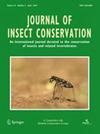贝母蝴蝶微生境需求及气候变化影响
IF 1.9
3区 农林科学
Q2 ENTOMOLOGY
引用次数: 0
摘要
Uncompahgre贝母蝶(Boloria improba acrocnema Gall LF, Sperling FAH, 1980)美国科罗拉多州西南部高海拔贝母蝶新种(蛱蝶科)。鳞翅目昆虫(J Lepidopterists ' Soc 34:23 - 252 1980)于1991年被列为联邦濒危物种,被认为是高山生态系统健康的栖息地指标。它们是在美国科罗拉多州圣胡安山脉孤立栖息地的小块柳上发现的。在这里,我们通过对7个亚群落(2003-2020年)的年度距离取样,以及对700个样点的草本盖度、土壤含水量、坡度、坡向和海拔的取样现状(2021年7月)测量,估算了历史上的粗粗粗尖孢杆菌丰度。我们使用回归模型来测试这些微生境特征对历史丰度的影响。结果表明,坡度从11°增加到31°,5种高山植物(S. nivalis、Geum rossii、Phacelia sericea、Noccaea fendleri和Lewisia pygmaea)的覆盖度增加,土壤含水量在0.09 ~ 0.38 m 3 /m 3之间,对蝴蝶丰度有正向影响。然而,海拔、光秃秃的地面覆盖度的增加以及planifolia Salix、Aster alpinus、Antennaria media和Androsace chamaejasme的存在与较低的丰度估计相关。气候变化导致高寒植物盖度下降、低海拔植物入侵或土壤湿度降低,从而导致大针叶虫丰度下降。这些结果强调了由于美国西部地区的范围限制和长期干旱条件,红腹大蠊的灭绝风险。通过定义红腹大蠊的额外资源需求,我们可以模拟气候对生存的影响,并考虑附近可能适合这种濒危物种居住的微栖息地。本文章由计算机程序翻译,如有差异,请以英文原文为准。
Microhabitat requirements of the uncompahgre fritillary butterfly (Boloria improba acrocnema) and climate change implications
Abstract The Uncompahgre fritillary butterfly ( Boloria improba acrocnema Gall LF, Sperling FAH (1980) A new high altitude species of Boloria from southwestern Colorado (Nyphalidae), with a discussion of phenetics and hierarchical decisions. J Lepidopterists’ Soc 34:230–252 1980) was listed as federally endangered in 1991 and is considered a habitat indicator for alpine ecosystem health. They are found on patches of Salix nivalis in isolated habitats of the San Juan Mountains, Colorado, USA. Here, we estimated historical B. i. acrocnema abundance from annual distance sampling (2003–2020) at seven sub-colonies and sampled current (July 2021) measurements of herbaceous coverage, soil moisture content, and slope, aspect, and elevation at 700 sample sites. We used regression models to test the effects of these microhabitat characteristics on historical abundance. Our results show that increases in slope from 11° to 31°, individual coverage of five alpine plant species ( S. nivalis , Geum rossii , Phacelia sericea , Noccaea fendleri , and Lewisia pygmaea ), and soil moisture content between 0.09 m 3 /m 3 and 0.38 m 3 /m 3 positively influence butterfly abundance. However, increases in elevation, bare ground coverage, and presence of Salix planifolia , Aster alpinus , Antennaria media , and Androsace chamaejasme were correlated with lower abundance estimates. Implications for insect conservation Effects of climate change which decrease coverage of these alpine plant species, allow encroachment of lower elevation species, or reduce soil moisture will decrease B. i. acrocnema abundance. These results emphasize the extinction risk of B. i. acrocnema due to range limitations and prolonged drought conditions in the Western U.S. By defining additional resource requirements of B. i. acrocnema , we can model climate effects on survivorship and consider nearby microhabitats that may be habitable by this endangered species.
求助全文
通过发布文献求助,成功后即可免费获取论文全文。
去求助
来源期刊
CiteScore
3.60
自引率
10.50%
发文量
76
审稿时长
6 months
期刊介绍:
The Journal of Insect Conservation is an international journal devoted to the publication of articles concerned with the conservation of insects and related invertebrates. The Journal of Insect Conservation publishes papers on all aspects of conservation and biodiversity related to the insects and closely related groups such as Arachnids and Myriapods, including ecological work which has conservation implications. Research papers may address the subject at the community, population or species level, may cover aspects of behaviour, taxonomy or genetics, be theoretical or practical, and be local or global in nature. Review articles are welcome as well as points of view which are likely to stimulate debate. From time to time the journal will publish Special Issues on specific subject areas which are the focus of current research. Proposals for such issues are welcome.

 求助内容:
求助内容: 应助结果提醒方式:
应助结果提醒方式:


